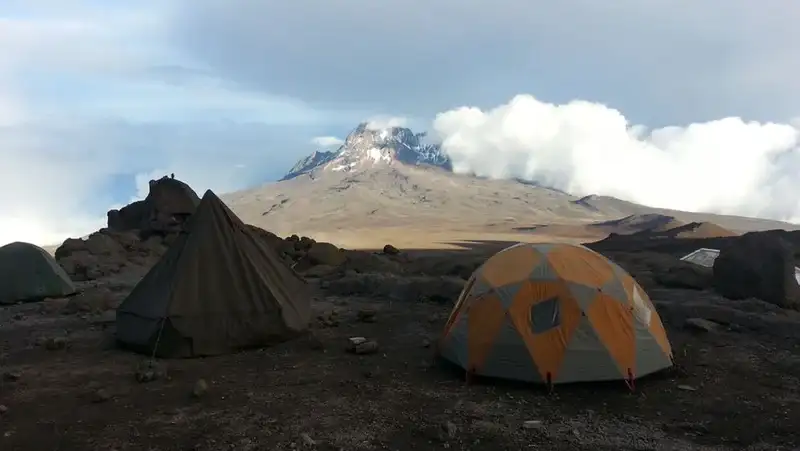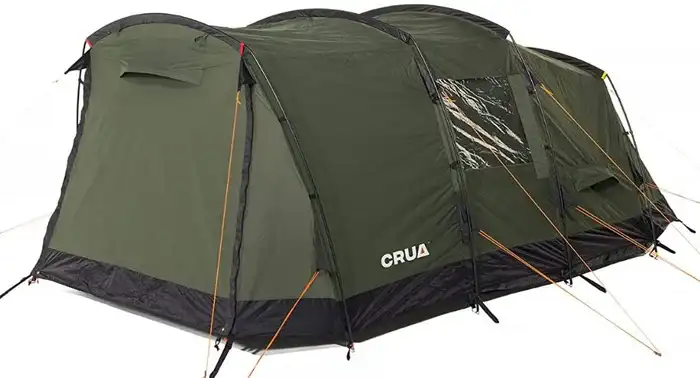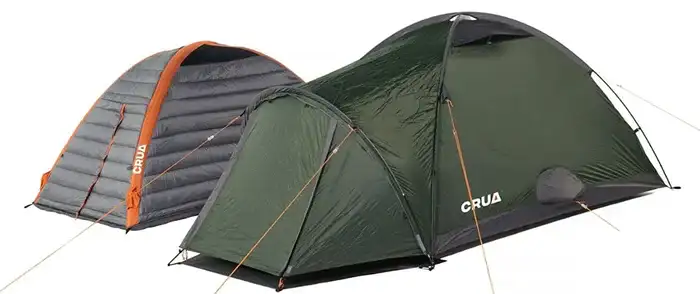Temperature inside a tent depends on its design and on outer conditions. So how much warmer is a 4 season tent? I can answer this question, so keep reading.
It would be necessary to know the terminology first. So 4-season tents are designed to perform reasonably well in all seasons, and this also means in all weather conditions.
In reality, it should be expected that they are more appropriate for a cooler environment than for warm summer camping. Quite generally, in my view, the closest to a true 4-season tent are cotton canvas tents and polycotton tents.
The terms 4-season tents and winter tents are frequently mixed. One could say that winter tents are extreme cases of 4-season tents.
Roughly speaking, the temperature in 4-season tents should be close to the lowest temperature in the winter tents. So expect up to 5 degrees Celsius higher temperature in a 4-season tent than outside. But there is more to this.

How many degrees warmer is in a tent than outside?
There are many factors that can make the difference. These may include:
- The type of the tent (low profile aerodynamic vs boxy and tall structure, single-layer vs double-layer, insulated vs non-insulated).
- Ventilation openings (closable vs non-closable).
- The weather conditions (sunny, cloudy, day, night, windy, calm weather).
- The outer temperature.
- People in the tent. This is because they develop heat and this makes the inner of a small tent warmer.
Non-insulated winter tents
Here are a few words about non-insulated tents but built for the most extreme conditions. So these are true winter tents, not necessarily 4-season tents.
There was a study performed by 14 students and 5 supervisors from the Gateway Antarctica, University of Canterbury. It was carried out at Windless Bight on the Ross Ice Shelf 8.8 km north of Scott Base in Antarctica, in the period from 21 December to 29 December 2009.
Related to this issue of tents, they had them three of different types. One was with a wooden pallet floor and the fly with two thick layers of canvas sewed together. This was a tunnel-shaped and large tent for group meetings and common use.
The other two tents had a thick waterproof floor and a two layer fly with an outer canvas and a thin inner nylon layer, so this was a true double-layer construction with an air gap of about 10 cm in between. These were small tents and with a pyramidal shape.
They measured temperature variations during the day and night, and also in sunny days vs cloudy days, with full and empty tents.
The conclusions were as follows:
- There was a temperature difference between inner and outer temperature in the range 5-15 degrees Celsius with small differences dependent on the type of the tent.
- The differences were bigger during sunny days.
- They detected the body effects in the large tent during group meetings, so the temperature was higher with people inside.
- There were no significant differences due to occupants in the small tents.
Note that the outer temperature was always below zero. So this was with un-insulated tents. Let’s see another type.
Insulated tents
As of the moment of writing this text, there is only one brand that is globally present, which builds insulated tents. This is Crua Outdoors. They have several insulated tents on the market.

In this video they test their Crua Tri 3 person insulated tent, have a look:
- Insulated tent had 59 F (15 C), so this was around 10 degrees C more.
- Single-wall winter tent had 48 F (8.9 C).
- Three season tent had 42 F (5.5 C).
So if you compare this with the high-quality winter tents used in the Antarctica experiment described above, the Crua tent could be comparable. Though in this Crua experiment the outer temperature was much higher than in the Antarctica experiment.
In view of this, the Crua tent is probably in the same level as those winter tents, and this is a bit surprising because of its thick inner insulated cocoon. I would expect it to perform even better.
Note that they have both larger and smaller tents than the Crua Tri mentioned above. Below is their smallest, the Crua Outdoors Duo 2 Person Tent. Note that this brand also has insulated roof top tents.

But what about 4-season tents?
Actually, there are no reliable data. There are only statements from some users here and there online. But you have seen the numbers from the Crua experiment above.
The three-season tent had the temperature only 1 degree Celsius higher, so if it is cold outside, it will be cold inside as well.
The single-layer winter tent had the temperature 4.5 degrees C higher. It would be reasonable to expect that a “typical” (whatever this term may imply) 4-season tent should have the temperature in between these two numbers. In other words, do not expect more than a couple of degrees Celsius or so. But…
There is an interesting study regarding 4-season refugee tents that are with three layers type with an insulated roof and with a waterproof floor.
The study was performed in Urfa in Turkey. It predicts that the inner temperature will be kept at least 6 degrees C warmer than the outside in winter, and at least 6 degrees C cooler in summer.
Relevant frequently asked questions
How do you keep a 4 season tent warm?
There is not much you can do. You are at mercy of the Nature and dependent on the tent’s design.
If it has vents and windows, and if they are closable, then you can try to see the best possible configuration to close as many as possible while still having enough air circulation to avoid excessive condensation.
It may help a bit to find a place where the tent is less exposed to wind, and orient it so that the door does not face the find direction.
Do I need a 4 season tent for winter?
No, you should have a true winter tent for winter camping. A true 4-season tent implicitly implies that it is built with some compromises so that it good enough for summer as well.
But you can definitely use a 4-season tent in winter. Make sure that you have the rest of the equipment for extreme conditions. This primarily means a sleeping pad with a high R-value and a warm sleeping bag.
Should I use a 4 season tent in the summer?
No you shouldn’t, but you can if you have no other tent available.
For summer you need a summer camping tent, and this means a tent with plenty of mesh openings, with vents, with large windows, etc.
What is the warmest tent?
The warmest tent is a heated tent. So the answer is easy. There are many tents on the market that come ready for wood-burning tent stoves. You can see some of them here.
Can a 3 season tent be used in winter? Can you use a summer tent in the winter?
It is yes to both of these questions, however, this does not mean you will feel great with such tents in a cold environment. If you really want to check how this is, it is best to test in controlled conditions so that you can escape if you are too cold.
You have seen some numbers in the Crua experiment above, it includes a 3-season tent as well. So the temperature inside is almost the same as the temperature outside.
Tents are there to protect you mainly from rain and wind, this is why they should be waterproof and have strong frame. The rest depends mainly on your sleeping equipment.
Is it warmer to sleep in a car or a tent?
If I can choose, I would always go for a car. This in particular if it is very windy outside. I had situations where I was sleeping in the car, and in the morning it was all in ice. But I was not so unbearably cold in the car.
I have seen some statement that are opposite to my view, but this is fine.
Final thoughts
In summary, from the results presented above, some 4 season tents can be warmer up to 6 degrees Celsius, and also cooler up to 6 degrees Celsius than the outside temperature. But in most cases this is not so, the temperature difference is smaller.
On the other hand, true winter tents can be up to 15 degrees Celsius warmer but this depends on a variety of factors and you cannot take this as a constant and rely on it completely. Rather think about a possible range of 5-15 degrees C.
You might want to read also my texts about 4-season and 4th-season tents differences. Thank you for reading. Let me know if you have questions, there is a comment box below.
Leave a Reply